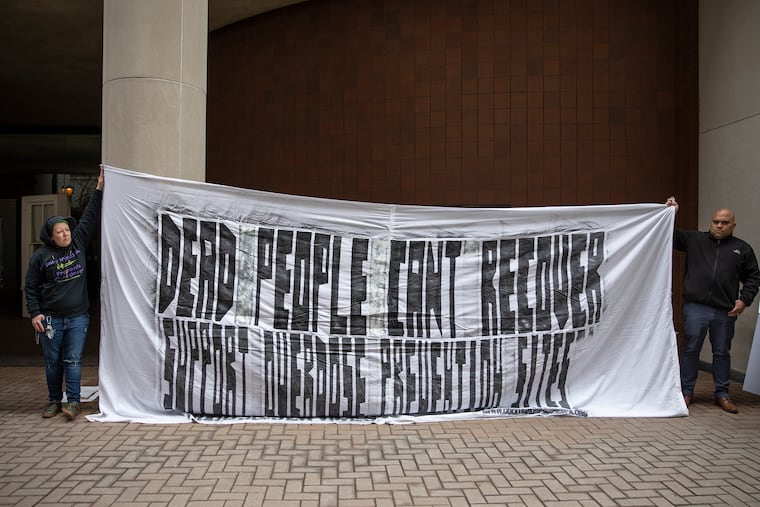Overdose prevention sites are a tool for racial justice | Opinion
The reaction to the crack epidemic was a mistake. But that doesn’t mean we should block anyone from effective remedies for saving lives, especially people of color.

Overdose prevention sites are lauded by people who use drugs as vital ways to save lives — something of urgent importance in Philadelphia. But overdose prevention sites have come under fire as perpetuating racism. These opponents advocate against the opening of a site in Philadelphia because black and brown people who used crack were funneled to prisons under the repressive policies of the war on drugs, whereas predominantly white opiate users are being offered a public-health intervention that would save lives and link users to treatment.
That argument ignores the many people of color negatively impacted by the opioid epidemic. Although the majority of opiate users are white, people of color are overrepresented in overdose deaths. According to the Centers for Disease Control and Prevention, the national rate of fatal drug overdoses has increased twice as fast for black people as it has for whites since 2014, largely due to fentanyl-laced heroin. In Philadelphia, black drug users accounted for nearly 30 percent of unintentional drug-related deaths from 2003 to 2017.
Critics are correct in calling out the massive race-based harms of the war on drugs. But their critiques of current interventions are misguided. Some have claimed that Ed Rendell’s support of a safe injection site, contrasted with his past policies on crack, indicates that he doesn’t care about black and brown drug users. In response, Rendell has said that if there had been a medical remedy for crack use when he was district attorney, he would have considered it.
The differential treatment of crack users is and was racist because medical research institutions haven’t considered it a priority to invest money in researching the mechanism of crack cravings and ways to address them in the ways analogous to what methadone and suboxone do for opiates. They haven’t prioritized this because of the racist and false perception that most crack users are black, and medical research has a long and dark history of neglecting communities of color. For instance, the cause of sickle-cell mutation, a disorder that affects predominantly people of color, has been known for 60 years, but there is no widely accessible or effective treatment to date. In contrast, effective treatments were identified for cystic fibrosis, a disease affecting primarily white people, 26 years after researchers discovered the cause.
An overdose prevention site (OPS) that served all modes of drug use would address the race-based harms of the war on drugs. As Kristen Maye and Kassandra Frederique of the Drug Policy Alliance pointed out, communities of color have “born the brunt of excessive policing and criminalization throughout the drug war.” Overdose prevention sites address this by offering communities of color an alternative to public use, which exposes them to the risk of arrest and incarceration. They also reduce the need to carry drug paraphernalia because OPS’ provide clean supplies, thereby further reducing the risk of arrest. They help underserved communities access much-needed services for addiction to any drug — not just the type of drug that is more closely associated with use by white people.
We believe that all Philadelphians, including drug users, should be treated with compassion. For communities of color, that means addressing the harms of the drug war through reparations. Overdose prevention sites can save cities millions of dollars by reducing ER visits and hospitalizations for overdose-related medical care, such as soft-tissue infections. This money should be used to make terrorized communities whole by creating a fund for reparations that can go toward reducing our disproportionately black and Latino prison population by half, and toward housing and health programs to support people in their own communities.
To determine exactly how the money should be spent, in the spirit of harm reduction, we believe that the city should consult with communities of color on their needs. Perhaps the city will find that people incarcerated for selling marijuana on the streets want the city to pay for licenses so that they can set up medical marijuana dispensaries, or for officials to issue a formal apology to communities of color that acknowledges the harms of the war on drugs.
Ultimately, the reaction to the crack epidemic was a mistake. But that doesn’t mean we should continue to implement misguided policies by blocking anyone from proven remedies for saving lives and keeping people healthier, especially people of color who continue to feel the painful ramifications of the war on drugs.
Aisha Mohammed, a family therapist, and Amna Shaikh, a nurse practitioner, are both members of Project SAFE, a direct-service and peer-based advocacy organization of women, nonbinary, gender nonconforming, and trans people in Philadelphia’s sex trade.